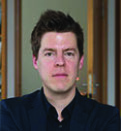In conversation, Philipp Kaiser comes across as the mild-mannered and cultivated European gentleman he is. But he has another agenda: To make members of the campus, especially students, take the world of the imagination seriously. He’s done this partly by teaching courses on art history, but also by serving as an adviser to the Public Art Committee, a CMC trustee-led effort to “put the art back in the liberal arts,” as President Hiram Chodosh has put it.
 “It’s really to spread an awareness, to create a dialogue about art on campus,” Kaiser says. “Art hasn’t been the first thing at Claremont McKenna,” in part because the school has been traditionally best known for politics and the social sciences.
“It’s really to spread an awareness, to create a dialogue about art on campus,” Kaiser says. “Art hasn’t been the first thing at Claremont McKenna,” in part because the school has been traditionally best known for politics and the social sciences.
Kaiser, who is a distinguished visiting fellow at the Gould Center for Humanistic Studies, had a hand in bringing Chris Burden’s “Meet in the Middle” to campus. The sculpture, donated by Trustee George R. Roberts ’66 P’93, now adorns the front entrance area of Roberts Pavilion. He has moderated two panels on public art, and is overseeing a speaking series that’s bringing important artists and art historians to campus.
The curator has taught at CMC since 2014, but he’s been well known to the visual art community in Southern California for a decade. He co-curated a well-received 2012 show at the Museum of Contemporary Art, “Ends of the Earth: Land Art to 1974,” devoted to a field which came into its own only in the 1960s and remains among Kaiser’s favorite genres. “The history hasn’t been written yet,” he says. “It’s still in flux and there are still so many misconceptions.”
A native of Switzerland whose early intellectual ambitions involved German philosophy and literature, Kaiser came to Los Angeles in 2007 for a job as curator at the Museum of Contemporary Art. Besides a year and a half at Cologne’s Museum Ludwig, he’s been here since.
Recently, Kaiser has become known for his curation of “Imitation of Life,” a four-decade, almost 130-piece retrospective on the photographer Cindy Sherman, at The Broad museum in downtown L.A. Kaiser felt no need to duplicate the style of a 2012 Museum of Modern Art show, but wanted to play up the New York artist’s resonance with Los Angeles: Though she typically is associated not with L.A. but with a group of East Coast artists known as the Pictures Generation (which also includes Barbara Kruger and David Salle), Kaiser wanted to frame her for the City of Angels.
Mostly, he wanted to explicitly make the connection between Sherman’s photographs and Hollywood movies, which serve as the model for many of them. “When you enter the show, there are huge murals from the ‘Rear-Screen Projection’ series,” Kaiser says. “It’s like a cinema screen. It pulls you in and announces the cinematic quality of the work.” The exhibit, which recently closed, also included a screening of the Sherman- directed movie “Office Killer,” which starred Carol Kane and Molly Ringwald.
The exhibit title — “Imitation of Life” —was chosen by Sherman and comes from a 1959 Douglas Sirk film starring Lana Turner and John Gavin. The film, which focuses on a black maid (played by Juanita Moore) who toils for a privileged family, is a meditation on race. Yet, beyond that, according to Kaiser, the film also considers reflection, mediation, and appropriation —concerns of postmodern art.
“The film is already a remake,” the curator says, referring to a 1934 John M. Stahl film. “So it’s an imitation of an imitation. ... That is a preoccupation of the Pictures Generation — that you mimic something that already exists. And a lot of that generation is obsessed with Douglas Sirk.”
Alongside his efforts on campus, Kaiser is also dedicated to getting students to take advantage of the cultural resources of Los Angeles, a city that has recently become a contemporary-art capital rivaled only by London and New York. In the spring, he teaches for the second time the course Sunshine and Noir: Los Angeles Art and Architecture, 1957-Present. “When I first moved here, you could go to all the shows, between La Cienega and Chinatown. Now it’s impossible. The artist-run spaces are popping up like mushrooms.” The local arts scene has also become more international. “There are many French people moving here.”
Robert Faggen, the Barton Evans and H. Andrea Neves Professor of Literature, and Gould Center director, calls Kaiser “very affable, energetic, and very versatile,” and considers him an important ally in the center’s efforts to bring a love of the intangible to students.
Kaiser has a busy year or so coming up He’s curating the Swiss Pavilion at the Venice Biennale, and putting together the inaugural exhibit at an important new art space in a the Masonic Temple on Wilshire Boulevard based on the collection of Maurice and Paul Marciano (Maurice is board co-chair for the Museum of Contemporary Art Los Angeles) called the Maurice and Paul Marciano Art Foundation.
“The exciting stuff is right in front of your door,” Kaiser says. “I always try to fully immerse myself in an environment.”


